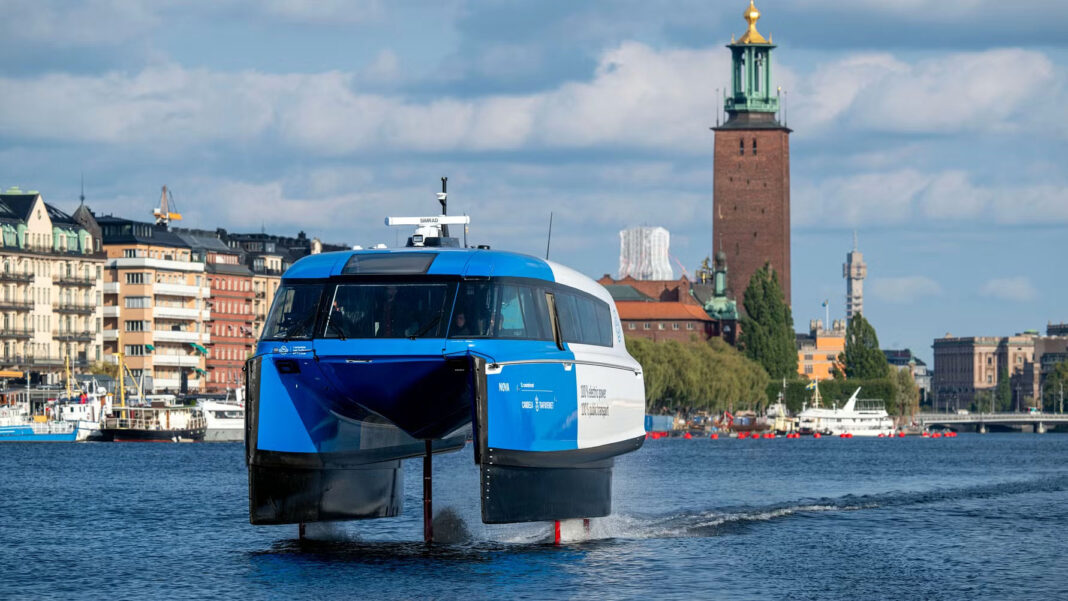The world’s first electric hydrofoil ferry has begun its service. Candela P-12 “Nova” sets out to eliminate emissions from Stockholm’s public transport while halving commute times.
“This is a paradigm shift for urban transport and a revival of our waterways,” says Gustav Hasselskog, founder and CEO of Candela.
At 07:15 on Tuesday 29 October 2024, Stockholm’s new ferry, “Nova”, departed from its dock in the suburb of Tappström, powered by its electric motors, and took off.
Flying silently a metre above the water’s surface, it completed the 15 km route to Stockholm’s City Hall in just over 30 minutes.
For the commuters on the world’s first electric foiling ship, the usual morning commute was almost cut in half. For Stockholm this may signal a future where city water transport is sustainable, affordable, and faster than travelling by car.
“Nova” is the first of Candela’s new P-12 model to enter service. Its computer-controlled hydrofoil wings lift the hull above water, reducing energy consumption by 80% compared to conventional vessels by cutting water friction.
“Conventional ships haven’t evolved much in 100 years and are among the least energy-efficient transport modes,” says Gustav Hasselskog.
The challenge with conventional fast vessels is that they consume enormous amounts of energy at high speeds, plowing through the water. This makes electrification difficult, as their range is limited even with large batteries.
Stockholm’s approximately 70 public transport vessels use more fossil fuels than the city’s buses and trains combined, despite representing only a small share of total ridership. Water transport is costly and slow, as the vessels create large wakes, limiting their speed in the city centre.
Yet, many commuters enjoy travelling by water. Region Stockholm aims to transition all vessels to renewable energy, with goals to reduce emissions and minimize disruptive wakes. Candela P-12’s hydrofoil technology is key to address these challenges.
Since “Nova” flies above the water rather than pushing through it like conventional vessels, it creates minimal wake. As a result, the ferry is allowed to travel at high speeds within the city limits, where other vessels are restricted by wake regulations.
“Nova” runs on 100% renewable electricity, and emits minimal noise even at high speeds, thanks to its electric C-POD motors with no mechanical transmission.
Thanks to its hydrofoil technology, “Nova” is not only the fastest electric ferry in operation in the world but also the fastest in Stockholm’s public transport fleet, cruising at 25 knots, outpacing the diesel-powered V-class ferries that previously held the speed record.
Ekerö, Stockholm’s fastest-growing island suburb, lies just 15 km from the city center. But commuting typically takes an hour by traditional ferries, limited by speed restrictions, or by bus/metro and car, subject to rush-hour congestion. By reducing travel times to a half hour, the new hydrofoil line brings Ekerö closer to the capital.
With its energy efficiency, “Nova” requires no costly dock infrastructure, charging instead at a regular car fast charger at the City Hall. Its long range allows it to match the schedule of conventional diesel ferries, with recharging during the typical lunch break.
“Nova” will operate through autumn 2024 until the waters freeze, resuming service in spring and continuing through August 2025. The route is a pilot project run by Candela, Trafikverket, and Region Stockholm (SL), aiming to explore how hydrofoil technology can enable faster, more affordable, and emissions-free maritime travel, creating new transit patterns in Stockholm.
Candela received orders from Saudi Arabia, New Zealand, and Berlin, with additional clients to be announced.


